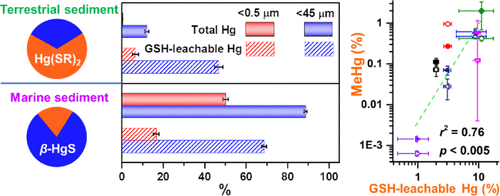当前位置:
X-MOL 学术
›
Environ. Sci. Technol.
›
论文详情
Our official English website, www.x-mol.net, welcomes your feedback! (Note: you will need to create a separate account there.)
Impacts of Sediment Particle Grain Size and Mercury Speciation on Mercury Bioavailability Potential
Environmental Science & Technology ( IF 11.4 ) Pub Date : 2021-09-10 , DOI: 10.1021/acs.est.1c03572 Jiang Xu 1, 2, 3 , Garret D Bland 2, 3 , Yuan Gu 2 , Hasti Ziaei 4 , Xiaoyue Xiao 2 , Amrika Deonarine 4 , Danny Reible 4 , Paul Bireta 5 , Thomas P Hoelen 5 , Gregory V Lowry 2, 3
Environmental Science & Technology ( IF 11.4 ) Pub Date : 2021-09-10 , DOI: 10.1021/acs.est.1c03572 Jiang Xu 1, 2, 3 , Garret D Bland 2, 3 , Yuan Gu 2 , Hasti Ziaei 4 , Xiaoyue Xiao 2 , Amrika Deonarine 4 , Danny Reible 4 , Paul Bireta 5 , Thomas P Hoelen 5 , Gregory V Lowry 2, 3
Affiliation

|
Particle-specific properties, including size and chemical speciation, affect the reactivity of mercury (Hg) in natural systems (e.g., dissolution or methylation). Here, terrestrial, river, and marine sediments were size-fractionated and characterized to correlate particle-specific properties of Hg-bearing solids with their bioavailability potential and measured biomethylation. Marine sediments contained ∼20–50% of the total Hg in the <0.5 μm size fraction, compared to only 0.5 and 3.0% in this size fraction for terrestrial and river sediments, respectively. X-ray absorption spectroscopy (XAS) analysis indicated that metacinnabar (β-HgS) was the main mercury species in a marine sediment, whereas organic Hg-thiol (Hg(SR)2) was the main mercury species in a terrestrial sediment. Single-particle inductively coupled plasma time-of-flight mass spectrometry analysis of the marine sediment suggests that half of the Hg in the <0.5 μm size fraction existed as individual nanoparticles, which were β-HgS based on XAS analyses. Glutathione-extractable mercury was higher for samples containing Hg(SR)2 species than β-HgS species and correlated well with the amount of Hg biomethylation. This particle-scale understanding of how Hg speciation and particle size affect mercury bioavailability potential helps explain the heterogeneity in Hg methylation in natural sediments.
中文翻译:

沉积物颗粒大小和汞形态对汞生物利用度潜力的影响
粒子特定的特性,包括大小和化学形态,会影响汞 (Hg) 在自然系统中的反应性(例如,溶解或甲基化)。在这里,对陆地、河流和海洋沉积物进行了尺寸分级和表征,以将含汞固体的颗粒特定特性与其生物利用度潜力和测量的生物甲基化相关联。海洋沉积物在小于 0.5 μm 的尺寸部分中包含总 Hg 的约 20-50%,而陆地和河流沉积物在这个尺寸部分中分别只有 0.5% 和 3.0%。X 射线吸收光谱 (XAS) 分析表明,metacinnabar (β-HgS) 是海洋沉积物中的主要汞物质,而有机 Hg-硫醇 (Hg(SR) 2) 是陆地沉积物中的主要汞种类。海洋沉积物的单粒子电感耦合等离子体飞行时间质谱分析表明,<0.5 μm 尺寸级分中的一半 Hg 以单个纳米粒子的形式存在,即基于 XAS 分析的 β-HgS。含有 Hg(SR) 2物种的样品的谷胱甘肽可提取汞高于β-HgS 物种,并且与 Hg 生物甲基化量相关。这种对汞形态和粒径如何影响汞生物利用度潜力的粒子尺度理解有助于解释天然沉积物中汞甲基化的异质性。
更新日期:2021-09-21
中文翻译:

沉积物颗粒大小和汞形态对汞生物利用度潜力的影响
粒子特定的特性,包括大小和化学形态,会影响汞 (Hg) 在自然系统中的反应性(例如,溶解或甲基化)。在这里,对陆地、河流和海洋沉积物进行了尺寸分级和表征,以将含汞固体的颗粒特定特性与其生物利用度潜力和测量的生物甲基化相关联。海洋沉积物在小于 0.5 μm 的尺寸部分中包含总 Hg 的约 20-50%,而陆地和河流沉积物在这个尺寸部分中分别只有 0.5% 和 3.0%。X 射线吸收光谱 (XAS) 分析表明,metacinnabar (β-HgS) 是海洋沉积物中的主要汞物质,而有机 Hg-硫醇 (Hg(SR) 2) 是陆地沉积物中的主要汞种类。海洋沉积物的单粒子电感耦合等离子体飞行时间质谱分析表明,<0.5 μm 尺寸级分中的一半 Hg 以单个纳米粒子的形式存在,即基于 XAS 分析的 β-HgS。含有 Hg(SR) 2物种的样品的谷胱甘肽可提取汞高于β-HgS 物种,并且与 Hg 生物甲基化量相关。这种对汞形态和粒径如何影响汞生物利用度潜力的粒子尺度理解有助于解释天然沉积物中汞甲基化的异质性。


























 京公网安备 11010802027423号
京公网安备 11010802027423号